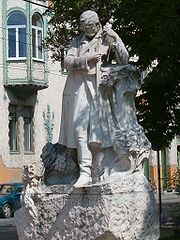
Pista Dankó
Encyclopedia

Hungary
Hungary , officially the Republic of Hungary , is a landlocked country in Central Europe. It is situated in the Carpathian Basin and is bordered by Slovakia to the north, Ukraine and Romania to the east, Serbia and Croatia to the south, Slovenia to the southwest and Austria to the west. The...
-born bandleader
Bandleader
A bandleader is the leader of a band of musicians. The term is most commonly, though not exclusively, used with a group that plays popular music as a small combo or a big band, such as one which plays jazz, blues, rhythm and blues or rock and roll music....
and composer
Composer
A composer is a person who creates music, either by musical notation or oral tradition, for interpretation and performance, or through direct manipulation of sonic material through electronic media...
belonging to the Romani people. He primarily worked in the folk music styles popular in Hungary in the 19th century. He was frequently known by the nickname "Nótafa", a Hungarian word meaning "ballad-singer of folk music".
Biography
Dankó was born in the Hungarian city of SzegedSzeged
' is the third largest city of Hungary, the largest city and regional centre of the Southern Great Plain and the county town of Csongrád county. The University of Szeged is one of the most distinguished universities in Hungary....
, where he began composing music at the age of 28. He belonged to a musical ensemble called "Hangászsor", or "row of musicians". He then moved to the city of Szatmar
Szatmár
Szatmár is the name of a historic administrative county of the Kingdom of Hungary. Its territory is presently in north-western Romania and north-eastern Hungary, south of the river Tisza...
, where he would meet and begin courting Ilonka Joó, the daughter of Szatmar's mayor. Since Dankó was a gypsy, the mayor disapproved of the relationship, prompting Dankó and Joó to elope. The two were together until Pista's death from lung disease in 1903.
Musical style
Due to Dankó's heritage, he was steeped in Hungarian folk musicHungarian folk music
Hungarian folk music includes a broad array of styles, including the recruitment dance verbunkos, the csárdás and nóta.During the 20th century, Hungarian composers were influenced by the traditional music of their nation which may be considered as a repeat of the early "nationalist" movement of the...
, and most of his works were written in the popular verbunkos
Verbunkos
Verbunkos is an 18th-century Hungarian dance and music genre. Erroneously, this genre was sometimes attributed to Gypsies, because usually they were the musicians, although the Magyars themselves were sometimes performers,as well....
and nóta
Nóta
Nóta is a form of 19th century Hungarian popular song. It is one of a number of styles collectively referred to as cigányzene, which literally means Gipsy music but is used to refer to a number of styles of Hungarian folk music that are played in a typical Gipsy musical style...
folk dance music styles. He also composed works in other styles such as marches
March (music)
A march, as a musical genre, is a piece of music with a strong regular rhythm which in origin was expressly written for marching to and most frequently performed by a military band. In mood, marches range from the moving death march in Wagner's Götterdämmerung to the brisk military marches of John...
.
Musical Works
While living in Szeged, Dankó composed music for over 400 poems, including the work of Lajos PósaLajos Pósa
Lajos Pósa was a Hungarian writer and poet. He created and edited a children's literary journal....
. One of his most popular songs of the time was Az a szép, az a szép (Handsome is He, Handsome is He), which is still among popular folk dance songs in Hungary. At the request of his associate Géza Gárdonyi
Géza Gárdonyi
Géza Gárdonyi, born Géza Ziegler was a Hungarian writer and journalist. Although he wrote a range of works, he had his greatest success as a historical novelist, particularly with Eclipse of the Crescent Moon and Slave of the Huns.-Life:Gárdonyi was born in Agárdpuszta, Austria-Hungary, the son of...
, a prominent Hungarian author, Dankó composed a march named A magyarok bejövetele (March of the Hungarians) for the thousandth anniversary of the Hungarian state in 1885. This work represented the pinnacle of Dankó's popularity in life, earning him a status rarely achieved by a Rom among the elite in Hungary.
Legacy
Dankó is a rare example of a Rom that was born into poverty and then rose to relative fame and fortune. He primarily did this by working to satisfy the musical taste of the public, and thus achieving popularity. As is often the case, Dankó received a considerable amount of recognition after his death, when following generations of Hungarians were even more enthusiastic and accepting of his music.A public statue of Dankó was erected in Szeged, on the bank of the Tisza
Tisza
The Tisza or Tisa is one of the main rivers of Central Europe. It rises in Ukraine, and is formed near Rakhiv by the junction of headwaters White Tisa, whose source is in the Chornohora mountains and Black Tisa, which springs in the Gorgany range...
river. A Hungarian-language film named Dankó Pista was also made based on his life, released in January 1941.

